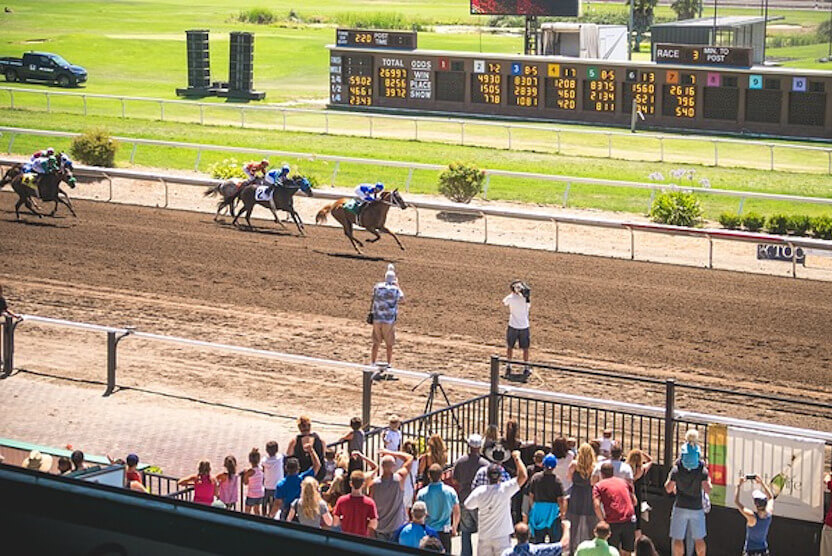

Nullam quis risus eget urna mollis ornare vel eu leo. Aenean lacinia bibendum nulla sed
- @skillable
 by
Eric McCafferty
by
Eric McCafferty

When making a bet on a horse or horses, you are buying into a pool of money that has been bet into that pool by all the other bettors. There will be separate pools of money for each wager type offered in a particular race. For instance, there will be a pool of money of all the bets made on the Win proposition. Likewise, all the Exacta bets are put into the Exacta pool, and so on. The payout from the pool is a function of a few variants: how much money is in the pool and what your fractional share would be, minus track expenses.
Let’s take that last one first. Before proceeds are paid from the pool, the horse track gets its cut, which is commonly referred to as the “Takeout.” Check out this article that explains how the takeout works. Different percentage cuts are made from the different pools, as the article explains. Hence, quite a lot less than 100% of the individual pool proceeds are returned in the form of winnings. You can also think of it this way, if you won your exacta bet at Churchill Downs, 22% is taken out of the pool, with only 78% of the pool being returned as winnings.
“Well when you’re sitting back, in your rose-pink Cadillac, making bets on Kentucky Derby Day”
– Rolling Stones
Parimutuel wagering does not use Fixed Odds, as are commonly found in sports wagering. Let’s consider an example where we bet a horse to Win a particular race, paying 5/1 at the time we placed the wager. As more money comes in on our horse, and less on the others, this may move our horse down to 2/1 odds. Whatever odds the horse goes off at, are the odds we will be paid at, if our horse wins. Remember, also, the Takeout happens before we get paid.
The point of all this, is we can never win at the correct odds rate. Our wins will never be paid out from 100% of the money in the pool. It is always less. One dollar bet into a pool with a Takeout of 22% means our dollar is now worth only 78 cents. And to get paid, we still must win the bet!
I am often reminded of lottery tickets. The lottery officials proudly proclaim that 50% of proceeds are returned as winnings. Most of us like parks and schools and public investments the proceeds are spent on, but what has effectively happened is our one dollar we spent on the ticket is now worth only 50 cents.
The bottom line is it is very difficult to make money haphazardly placing parimutuel wagers. Favorites often win. Longshots rarely win. You need an angle to bet on horses, or you need to bet only days where the pools are big enough to pay you off, when you hit.
The Triple Crown races are excellent days to make parimutuel wagers. The pools are huge, so you get paid well, when you hit. Every track has some kind of Stakes Race. On big race days or weekends, like Kentucky Derby Day, there will be numerous stakes races. These races have the best horses, the best jockeys and huge pools you can claim a share of when you hit. Focus on only betting these days.
Another betting angle is this: all tracks have a season, typically known as a “meet.” On the last day of the Meet, any jackpots, like a Pick 6, that have not been won and have been carried over from day to day, require a Mandatory Payout. Sometimes, these payouts can be in the millions of dollars. This is a very good way to take a shot at a huge pool of money, with limited risk.
Finally, lets understand what the toteboard odds really mean. The track oddsmaker sets the Morning Line based on a variety of factors he knows about the individual horses, their current form and how they have fared in in competition. This is where your handicapping comes in to play. There are so many angles to handicapping horses that I have neither the time nor space to cover. But, the most important thing to remember is, if you are going to be an Advantage Player handicapping and wagering on horses, you need to find the angle that works best for your skill set and approach. And bet only those races that will pay you off when you hit.
The odds displayed on the toteboard do not represent each horse’s actual chance of winning. Rather, it represents what bettors think those chances of winning are, based on how they actually bet. Odds are based on the Win pool only. The lower the odds on the toteboard, the better the chances of that horse winning, in the estimation of the betting public. The odds are set by the amount of money the public bets on each horse.
Here is what your $2-win bet will pay, if your horse wins (payouts are approximate):
| ODDS | PAYOUT | ODDS | PAYOUT | ODDS | PAYOUT |
|---|---|---|---|---|---|
| 1-9 | $2.10 | 9-5 | $5.60 | 9-1 | $20.00 |
| 1-5 | $2.40 | 2-1 | $6.00 | 10-1 | $22.00 |
| 2-5 | $2.80 | 5-2 | $7.00 | 15-1 | $32.00 |
| 1-2 | $3.00 | 3-1 | $8.00 | 20-1 | $42.00 |
| 3-5 | $3.20 | 7-2 | $9.00 | 25-1 | $52.00 |
| 4-5 | $3.60 | 4-1 | $10.00 | 30-1 | $62.00 |
| 1-1 | $4.00 | 9-2 | $11.00 | 40-1 | $82.00 |
| 6-5 | $4.40 | 5-1 | $12.00 | 50-1 | $102.00 |
| 7-5 | $4.80 | 6-1 | $14.00 | 99-1 | $200.00+ |
| 3-2 | $5.00 | 7-1 | $16.00 | ||
| 8-5 | $5.20 | 8-1 | $18.00 |

Nullam quis risus eget urna mollis ornare vel eu leo. Aenean lacinia bibendum nulla sed
